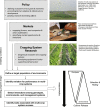Toward plant breeding for multicrop systems
- PMID: 36972435
- PMCID: PMC10083599
- DOI: 10.1073/pnas.2205792119
Toward plant breeding for multicrop systems
Abstract
Increasing cropping system diversity has great potential to address environmental problems associated with modern agriculture, such as erosion, soil carbon loss, nutrient runoff, water pollution, and loss of biodiversity. As with other agricultural sciences, plant breeding has primarily been conducted in the context of dominant monoculture cropping systems, with little focus on multicrop systems. Multicrop systems have increased temporal and/or spatial diversity and include a diverse set of crops and practices. In order to support a transition to multicrop systems, plant breeders must shift their breeding programs and objectives to better represent more diverse systems, including diverse rotations, alternate-season crops, ecosystem service crops, and intercropping systems. The degree to which breeding methods need to change will depend on the cropping system context in question. Plant breeding alone, however, cannot drive adoption of multicrop systems. Alongside shifts in breeding approaches, changes are needed within broader research, private sector, and policy contexts. These changes include policies and investments that support a transition to multicrop systems, increased collaboration across disciplines to support cropping system development, and leadership from both the public and private sectors to develop and promote adoption of new cultivars.
Keywords: crop diversity; cropping systems; plant breeding; sustainability.
Conflict of interest statement
The authors declare no competing interest.
Figures


References
-
- Altieri M. A., The ecological role of biodiversity in agroecosystems. Agric. Ecosyst. Environ. 74, 19–31 (1999).
-
- Horwith B., A role for intercropping in modern agriculture. Bioscience 35, 286–291 (1985).
-
- Brooker R. W., et al. , Improving intercropping: A synthesis of research in agronomy, plant physiology and ecology. New Phytol. 206, 107–117 (2015). - PubMed
-
- Anil L., Park J., Phipps R. H., Miller F. A., Temperate intercropping of cereals for forage: A review of the potential for growth and utilization with particular reference to the UK. Grass Forage Sci. 53, 301–317 (1998).
-
- Crews T. E., Peoples M. B., Legume versus fertilizer sources of nitrogen: Ecological tradeoffs and human needs. Agric. Ecosyst. Environ. 102, 279–297 (2004).
MeSH terms
Substances
LinkOut - more resources
Full Text Sources
Research Materials

